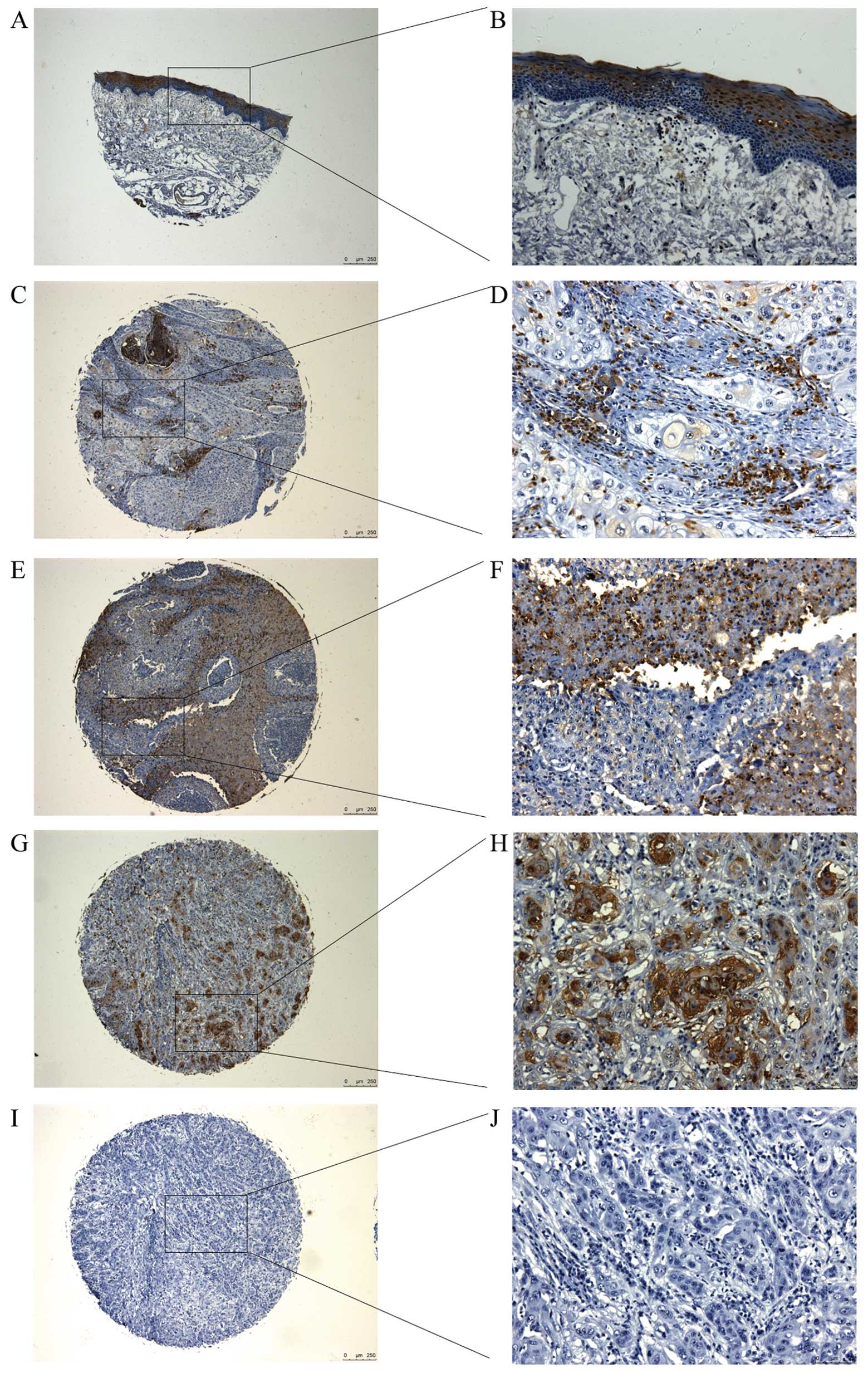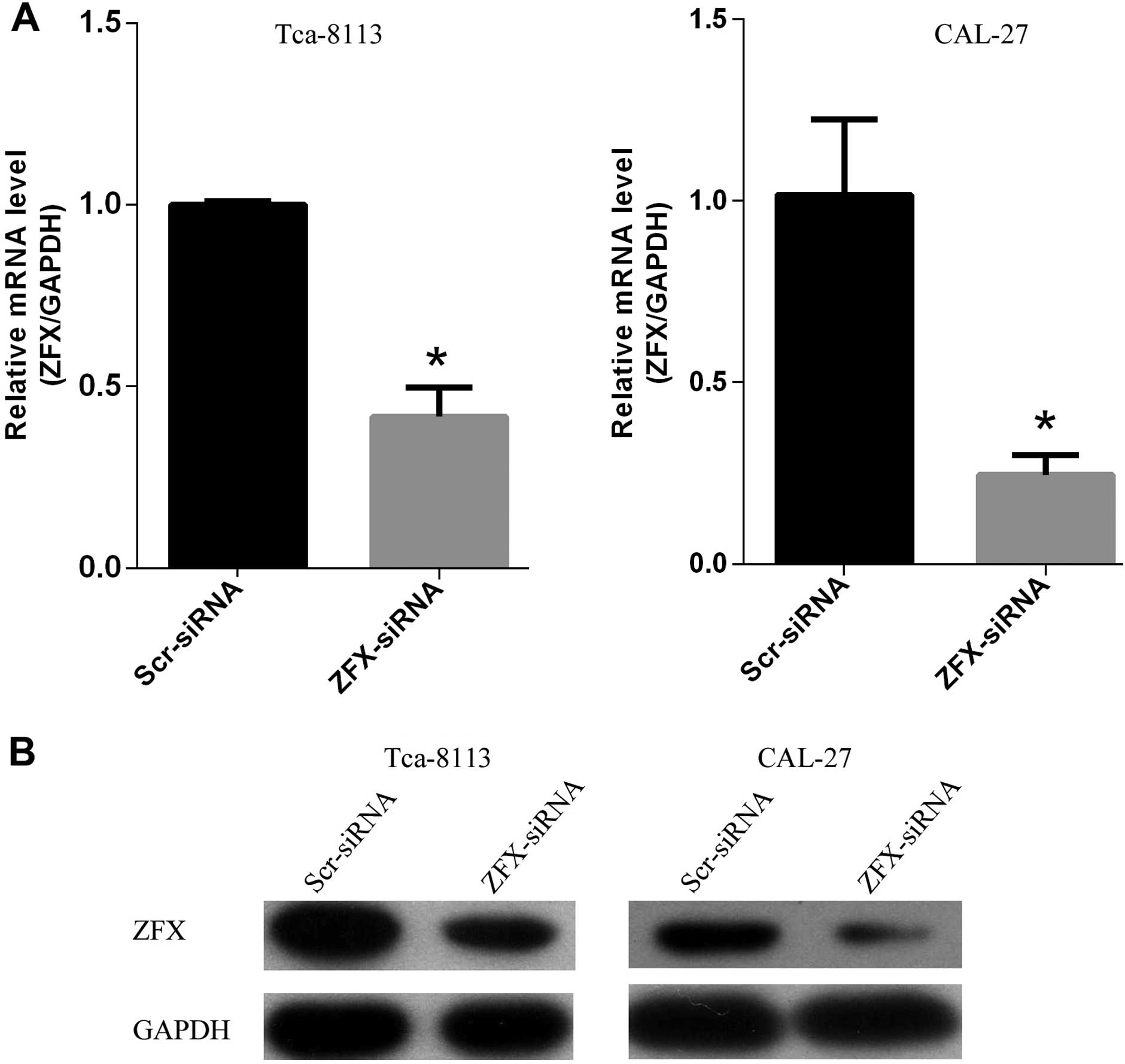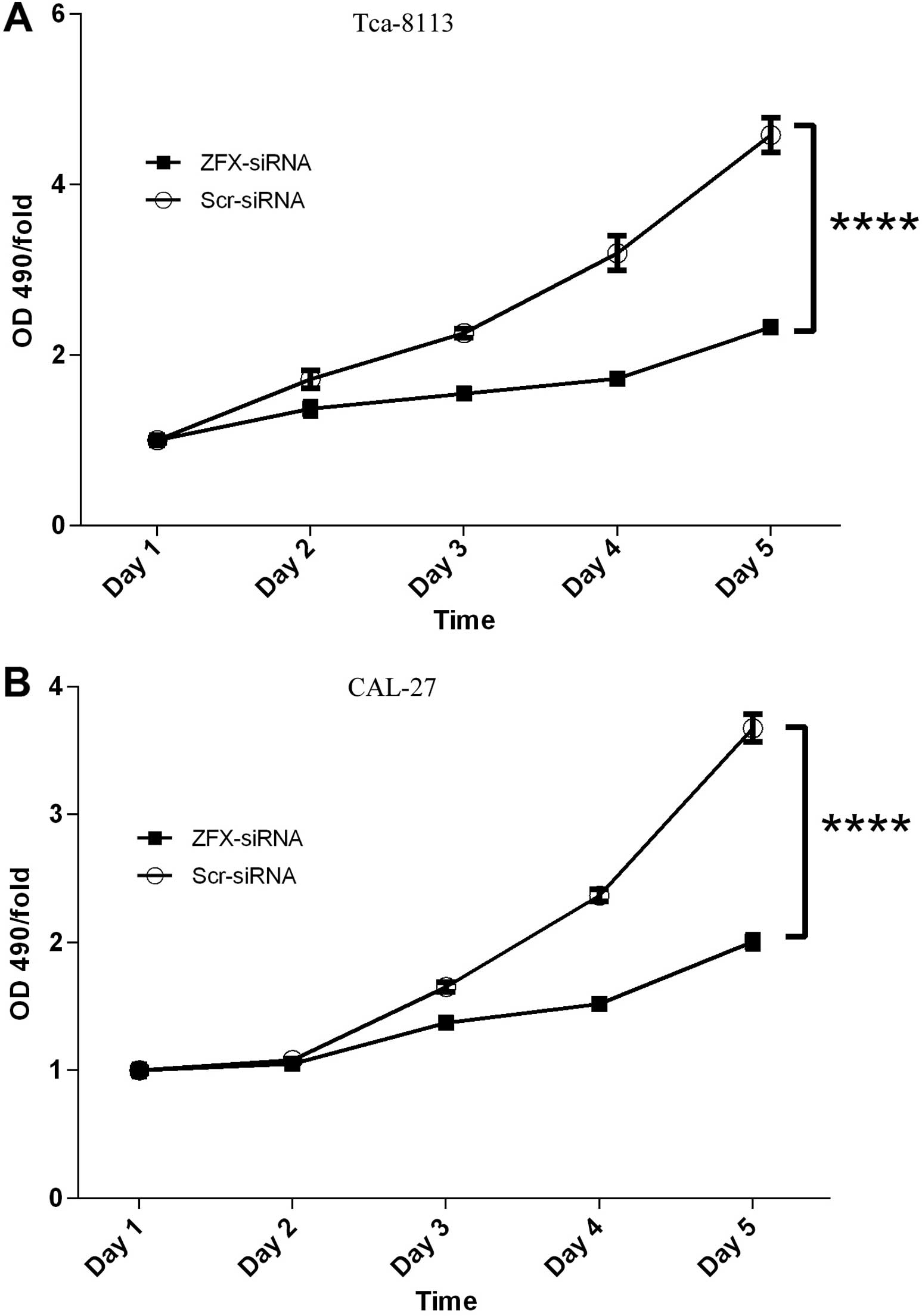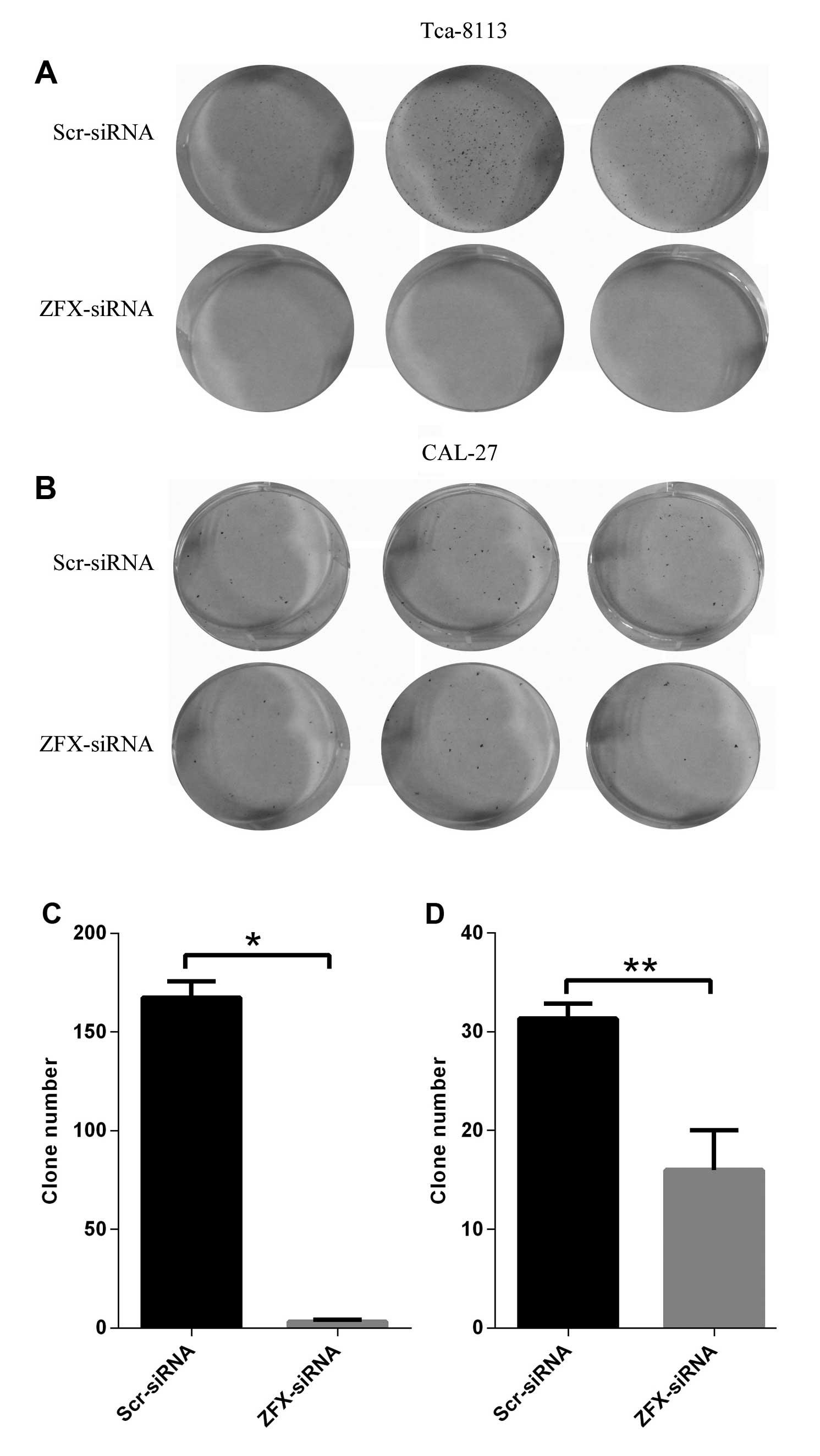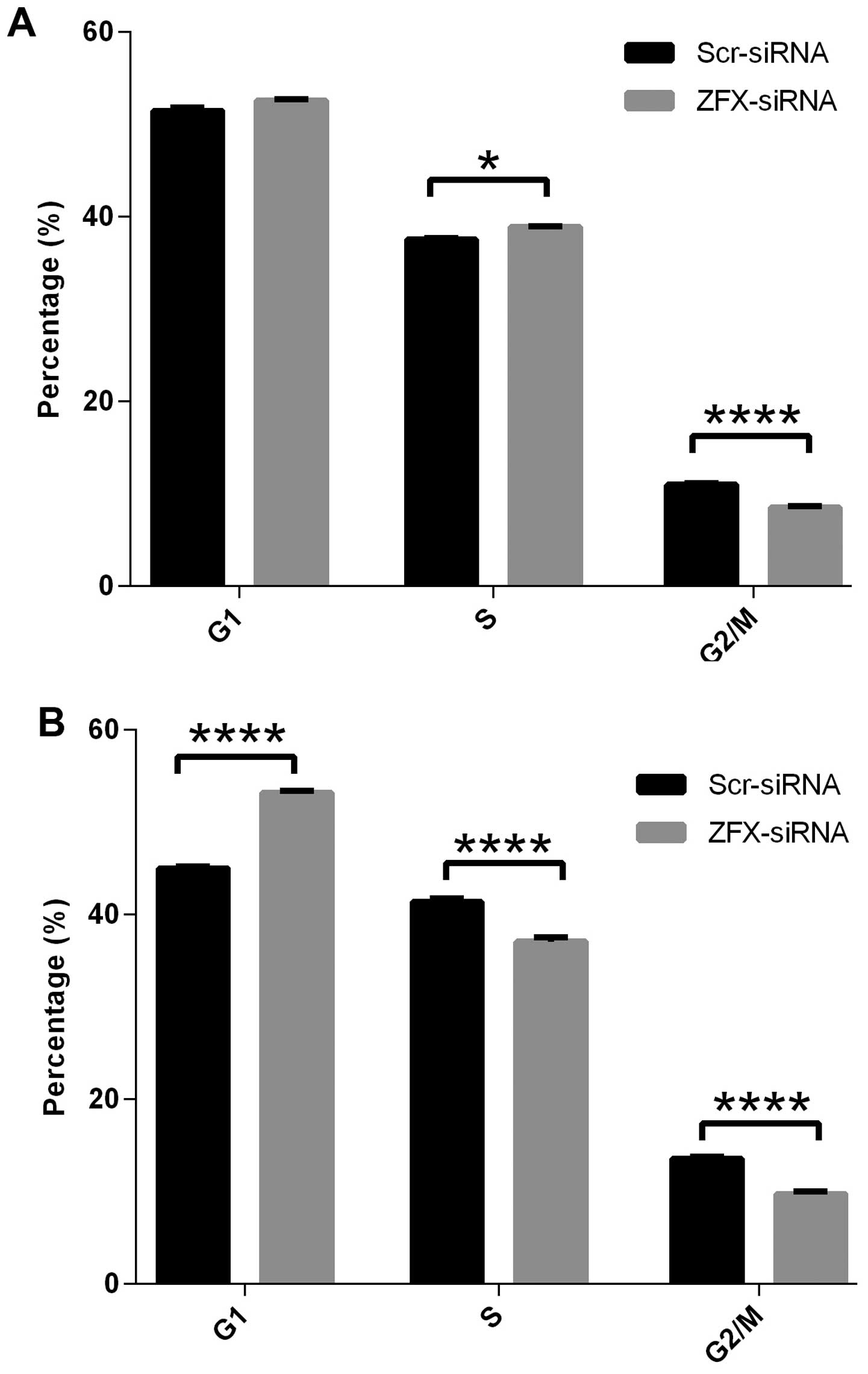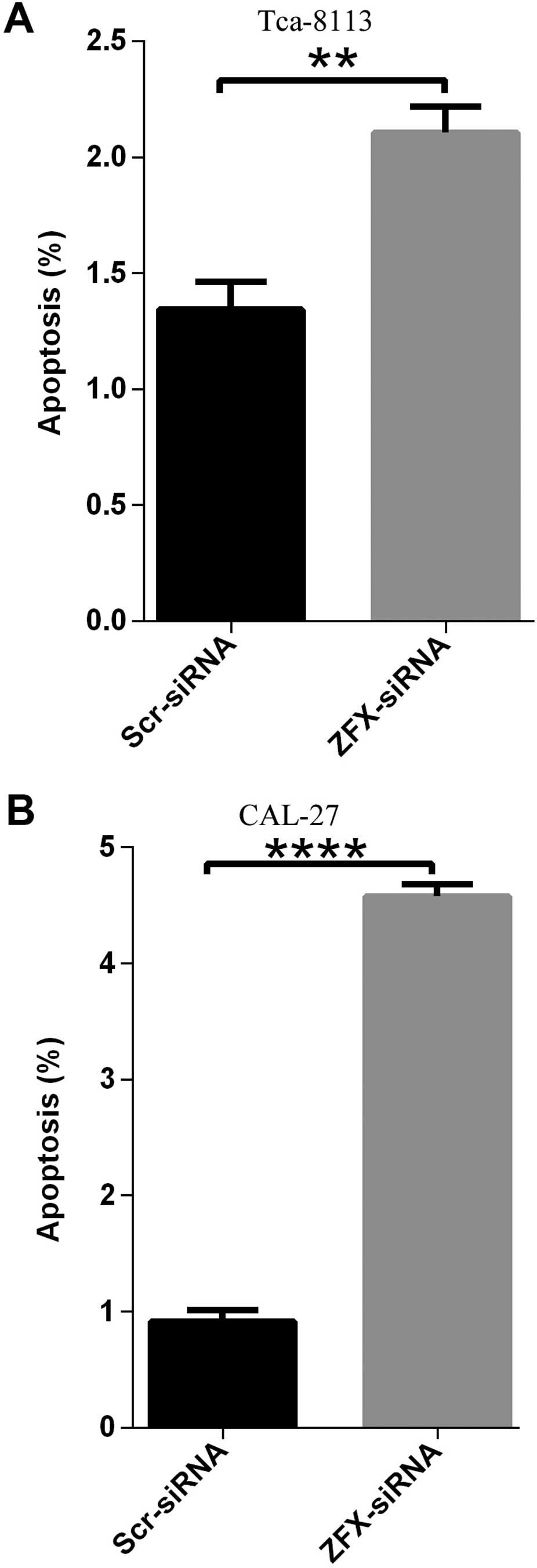Overexpression of ZFX and its involvement in squamous cell carcinoma of the tongue
- Authors:
- Published online on: October 29, 2014 https://doi.org/10.3892/or.2014.3572
- Pages: 141-148
Abstract
Introduction
Cancer of the oral cavity and oropharynx is among the top 10 leading cancers worldwide (1). The most common malignant type is squamous cell carcinoma (SCC) of the tongue. Even more serious is that most tongue SCC cases are in advanced stages when diagnosed and effective treatment is quite rare. Furthermore, little improvement has been achieved in the past two decades for the 5-year survival rate of tongue SCC patients (2) even though medical and surgical treatment have made huge advances in cancer therapy. A causal relationship has been established between tongue SCC and several risk factors such as drinking and smoking, yet the molecular pathways underlying tumorigenesis and progression remain elusive. Exploring the underlying mechanisms will provide valuable information for the prevention, diagnosis and treatment of tongue SCC.
Zinc finger protein, X-linked (ZFX), encoded by the gene ZFX located on the X chromosome, is a member of the ZFY protein family and has been identified as a transcription factor. ZFX is composed of three functional domains including a DNA binding domain containing 13 C2H2-type zinc fingers, a nuclear localization sequence and an acidic transcriptional activation domain. Functional analysis has shown that ZFX is essential for the survival and self-renewal of embryonic and hematopoietic stem cells (3). Moreover, further research has unraveled the involvement of ZFX protein in the propagation of leukemia cells in acute myeloid leukemia (AML) and acute T-lymphoblastic leukemia (T-ALL) (4). In addition, ZFX also plays important roles in the initiation and progression of multiple types of cancer. However, the relationship between ZFX and tongue SCC is still unclear.
Here, we tried to explore the role of ZFX in tongue SCC development and progression. We first analyzed the expression pattern of ZFX protein in tissue samples derived from tongue SCC patients, and confirmed that ZFX expression is upregulated in tongue SCC patients. Then an efficient siRNA targeting the human ZFX gene was designed, and a lentiviral system was used to manipulate ZFX gene expression in two human tongue SCC cell lines, Tca-8113 and CAL-27, which were derived from a male and female patient, respectively. The impact of ZFX knockdown on cell proliferation, apoptosis and cell cycle distribution was investigated extensively, confirming the indispensable role of ZFX for tongue SCC development and progression. Thus, our results provide evidence that ZFX is a promising target for tongue SCC treatment.
Materials and methods
Preparation of clinical tumor samples and immunohistochemical (IHC) staining
In the present study we obtained informed consent from all patients. This study was approved by the ethics committee of our institution. Fifty clinical samples from patients with SCC of the tongue were collected, and patient information is described in Table I. Ten normal tongue tissues were used as negative control. ZFX IHC staining was performed in the tumor samples as described previously (5). Briefly, ZFX expression was detected with the NBP1-80582 ZFX antibody purchased from Novus Company. Staining was conducted with an EliVision™ Plus kit (Fuzhou Maixin Biotechnology Co., Ltd.). Then, ZFX expression by IHC staining was determined independently by two experienced pathologists blinded to all clinical data, and ZFX signals were scored as follows: − (<5% positive staining), + (6–100% positive staining).
Table IAssociation between ZFX expression and pathological parameters of the tongue SCC cases (cases, %) by IHC staining. |
Lentivirus-mediated siRNA targeting the ZFX gene
Strategy with a lentiviral system expressing small interfering RNA (siRNA) targeting the ZFX gene was employed to manipulate ZFX expression as previously described (6). Briefly, we first designed efficient siRNA (siRNA sequence, GAGCCTGAGAATGATCATGGA) specifically targeting the human ZFX gene, while the sequence of the siRNA used as the negative control was: TTCTCCGAACGTGTCACGT. Then, stem-loop DNA oligonucleotides were synthesized, annealed and inserted into the lentiviral vector pGCSIL-GFP. The vector plasmids and two helper plasmids were then co-transfected into 293T cells to generate the lentivirus expressing scrambled siRNA or siRNA targeting the human ZFX gene. Two human tongue SCC cell lines, Tca-8113 and CAL-27, were infected with the lentivirus expressing scrambled siRNA or siRNA targeting the human ZFX gene to determine the knockdown efficiency at the protein and RNA levels using western blotting and real-time PCR.
Cell cycle analysis by fluorescence-activated cell sorting technology
The method used to perform cell cycle analysis was previously described with slight modifications (7). Briefly, two human tongue SCC cell lines, Tca-8113 and CAL-27, were treated with the lentivirus expressing siRNA targeting the human ZFX gene or the scrambled siRNA and incubated for 4 days. Cells were then resuspended and seeded in 6-cm dishes for further incubation. After ~80% coverage was achieved, we harvested the cells and fixed them with ice-cold 70% alcohol for at least 1 h. Staining solution was prepared using 40X PI stock (2 mg/ml), 100X RNase stock (10 mg/ml) and 1X phosphate-buffered saline (PBS) buffer at a dilution of 25:10:1,000. Cells were then stained with the staining buffer after washing with PBS solutions. Then, FACSCalibur (Becton-Dickinson, USA) was used to perform cell cycle analysis. At least 1×106 cells/sample were used for cell cycle analysis, and three independent experiments were carried out.
Cell apoptosis analysis by FACS
Annexin V-APC staining was used to perform cell apoptosis analysis. Briefly, the lentivirus expressing ZFX siRNA or scrambled siRNA was added to the Tca-8113 and CAL-27 cells, and the cells were incubated at 37°C for 4 days. Cells were then collected and washed with PBS buffer. Staining buffer was used to resuspend the cells at a final density of 1×106 – 1×107/ml. Then 100 μl of the cell suspensions were mixed with 5 μl Annexin V-APC and incubated at room temperature in the dark for 10–15 min. FACSCalibur (Becton-Dickinson, USA) was used to analyze the cell apoptosis profiles.
Colony formation assay
A colony formation assay was performed as previously described (8). Tca-8113 and CAL-27 cells were treated with the lentivirus expressing ZFX siRNA or scrambled siRNA and then cultured for 48 h. Cells were collected in the logarithmic phase. Cells were counted with a haemocytometer, and 800 cells/well were seeded in triplicate into 6-well plates. Then cells were cultured in a 5% CO2 incubator at 37°C for another 14 days. After fixation with paraformaldehyde for 30–60 min, the cells were stained with Giemsa for 20 min. Images of the cell plates were captured using micropublisher 3.3 RTV (Olympus) after washing with distilled water. Cell colonies under each condition were counted and analyzed.
Cell proliferation analysis by MTT assay
Cell proliferation was analyzed using the MTT assay. The lentivirus expressing ZFX siRNA or scrambled siRNA was added to the Tca-8113 and CAL-27 cells, and the cells were incubated for 48 h. The cells were then trypsinized in the logarithmic phase and resus-pended thoroughly with culture medium. After counting with a haemocytometer, 2,000 cells/well were seeded in 96-well plates in quintuplicate and cultured in a 5% CO2 incubator at 37°C. Cell proliferation was analyzed each day for 5 days using the MTT assay. Briefly, 20 μl of MTT solution (5 mg/ml) was added into each well and incubation was continued for another 4 h. Then culture medium was discarded and 150 μl of DMSO was added to dissolve the formazan. The plate was under constant shaking for 5–10 min and then the absorbance at 490/570 nm was measured with a microplate reader.
RNA isolation and real-time quantitative PCR
Tca-8113 and CAL-27 cells were infected with the lentivirus expressing ZFX siRNA or scrambled siRNA and cultured for another 2 days. Then total RNA of these cultured tumor cells was isolated using TRIzol (Invitrogen) according to the manufacturer’s instructions. Reverse transcription was performed using 2 μg RNA, M-MLV reverse transcriptase (Promega) and oligo(dT) primers (Sangon, Shanghai) to produce cDNAs. To quantify ZFX expression in the Tca-8113 and CAL-27 cells infected with the lentivirus expressing siRNA targeting ZFX, real-time quantitative PCR was performed using a real-time PCR machine TP800 (Takara), and glyceraldehyde-3-phosphate dehydrogenase (GAPDH) was used as an internal reference. Primers used in real-time PCR were as follows: GAPDH forward, 5′-TGACTTCAACAGCGACACCCA-3′ and GAPDH reverse, 5′-CACCCTGTTGCTGTAGCCAAA-3′; ZFX forward, 5′-GGCAGTCCACAGCAAGAAC-3′ and ZFX reverse, 5′-TTGGTATCCGAGAAAGTCAGAAG-3′. ZFX expression data were normalized to GAPDH, and the comparative Ct method was chosen to analyze the expression changes of ZFX.
Western blotting
Western blotting was chosen to examine ZFX protein levels to determine the knockdown efficiency of the lentivirus expressing ZFX siRNA in the Tca-8113 and CAL-27 cells. Briefly, the lentivirus expressing ZFX siRNA or scrambled siRNA was added to the Tca-8113 or CAL-27 cells, and then cells were cultured for another 96 h. Cells were harvested, lysed with modified RIPA buffer, boiled in 1X SDS loading buffer and resolved by 10% SDS-PAGE. The gel was transferred to PVDF membranes (Amersham), and the membranes were blocked with 5% milk in Tris-buffered saline containing 0.1% Tween-20 (TBST) buffer for 1 h. They were then incubated overnight at 4°C with the primary antibodies, washed three times in TBST, and the signals were detected by HRP reaction using the SuperSignal Chemiluminescent Substrate (Pierce).
Statistical analysis
Data analysis was performed with GraphPad Prism 6 software, and experiments in the present study were repeated at least three times. Student’s two-tailed t-test was used to analyze the significant differences between groups, and P<0.05 was considered to indicate a statistically significant result. Data in Table I were analyzed with SPSS 14.0 software and the method used was Pearson’s Chi-square test.
Results
Aberrant high expression of ZFX protein in tissue samples of tongue SCC patients
Aberrant expression of ZFX protein is prevalent in multiple types of cancer, and here we evaluated its expression in clinical specimens from tongue SCC patients using IHC staining. We found that in normal tongue tissues, ZFX protein was mainly expressed in the nucleus of the epithelium and its expression in mesenchyma was quite weak (Fig. 1A and B) while in the tumor samples from tongue SCC patients, ZFX expression increased with advanced clinical stage (Fig. 1C–H). Furthermore, ZFX protein could be detected in both the nucleus and cytoplasm in samples of tongue SCC patients, in contrast to the nuclear localization in normal tissues. In addition, we further analyzed the relationship between ZFX expression and diverse clinicopathological parameters as shown in Table I. Indeed, a positive ZFX signal was detected in all (17/17) stage II–IV tongue SCC samples while a positive ZFX signal was detected in 81.81% (26/33) of the stage I samples (χ2=4.193, P=0.041). Furthermore, when analyzed using the tumor grading system, a positive ZFX signal was detected in all (19/19) grade II–III tongue SCC samples and in 77.41% (24/31) of grade I samples (χ2=4.989, P=0.026), suggesting that ZFX protein expression was positively correlated with tumor grade and stage (TNM). We further noted that ZFX expression in tongue SCC patients was strongly associated with gender, as a positive ZFX signal was observed in 96.42% (27/28) of the tongue SCC samples from male patients while only in 72.72% (16/22) of samples from female patients (χ2=5.748, P=0.017). However, no significant relationship was observed between ZFX expression and patient age (χ2=0.166, P=0.684). Taken together, our results showed that ZFX expression was higher in tongue SCC tumors, and increased ZFX expression was correlated with high tumor grade and stage, suggesting that ZFX may be essential for the development and progression of tongue SCC.
Efficient knockdown of ZFX in human tongue SCC cell lines
To better characterize the functions of ZFX in human tongue SCC cell lines Tca-8113 and CAL-27, we employed lentivirus-based siRNA strategy to knock down the expression of human ZFX in both tumor cell lines. Tca-8113 and CAL-27 cells were first infected with the lentivirus expressing scrambled siRNA or siRNA targeting human ZFX and cultured for another two days. Then proteins and total RNAs were isolated to determine the knockdown efficiency. Approximately a 61.4% reduction in ZFX mRNA was achieved in the Tca-8113 cells and 75.4% knockdown efficiency was achieved in the CAL-27 cells (Fig. 2A). Furthermore, western blot analysis of ZFX protein levels confirmed the high inhibitory effect of siRNA strategy on ZFX expression at the protein level (Fig. 2B). These results indicated that the lentivirus-based siRNA strategy inhibited the expression of ZFX in both cell lines efficiently and was chosen for subsequent experiments to manipulate ZFX expression.
Inhibition of proliferation of human tongue SCC cell lines by ZFX knockdown
It has been reported that ZFX is essential for the self-renewal of stem cells, implicating the involvement of ZFX in the cell proliferation process. It is well known that unlimited proliferation is a hallmark of cancer, thus here we evaluated the impact of ZFX knockdown on the proliferation of two human tongue SCC Tca-8113 and CAL-27 cell lines. Both cell lines were infected with the lentivirus expressing scrambled siRNA or siRNA targeting human ZFX efficiently. Then the cell proliferation profiles were analyzed with MTT assay every day for 5 days. In both cell lines ZFX knockdown barely affected the proliferation in the first 3 days after transfection. However, cell proliferation impairment became obvious in both cell lines infected with the lentivirus expressing the siRNA targeting human ZFX after 4 days of transfection, and the proliferation fold decreased from 2.4 in cells expressing scrambled siRNA to 1.5 in ZFX-knockdown cells. Furthermore, the proliferation inhibitory effect was even more obvious after 5 days of transfection, indicating that proliferation suppression was positively correlated with the duration of cell culture (Fig. 3A and B).
Suppression of colony formation by ZFX depletion in human tongue SCC cell lines
Unlimited cell division is critical for tumorigenesis, and the colony formation assay reflects the ability of a single cell to form a colony which is composed of at least 50 cells. Thus, we carried out a colony formation assay in both CAL-27 and Tca-8113 cells to evaluate the impact of ZFX depletion on the clonogenic capacity of the human tongue SCC cell lines. Our results showed that ZFX depletion with the lentivirus expressing human ZFX siRNA significantly impaired the colony formation ability of both cell lines. An average of 31 clones formed in the CAL-27 cells expressing scrambled siRNA while only 16 clones were detected in the ZFX-depleted CAL-27 cells (Fig. 4B and D). Consistent with these results, ZFX knockdown in the Tca-8113 cells inhibited the colony formation even more significantly, with 167 clones formed in cells expressing scrambled siRNA and only 3 clones in the ZFX-depleted cells (Fig. 4A and C). Thus, the results from both cell lines provided evidence that ZFX is critical for the colony formation in human tongue squamous cell carcinoma cell lines, implicating the involvement of ZFX in the progression of human tongue SCC.
Cell cycle arrest by ZFX knockdown
It has been demonstrated that ZFX is essential for the self-renewal of stem cells. In the present study we showed that ZFX knockdown suppressed the proliferation of human tongue SCC Tca-8113 and CAL-27 cell lines. To explore the underlying mechanisms of cell proliferation impairment by ZFX knockdown, we examined the cell cycle distribution of Tca-8113 and CAL-27 cells infected with the lentivirus expressing specific siRNAs. Analysis with fluorescence-activated cell sorting (FACS) showed that ZFX knockdown led to cell cycle arrest in both cell lines. As shown in Fig. 5, ZFX knockdown in CAL-27 cells led to a significant G1 phase arrest with a simultaneous reduction of both S and G2/M phase cells. The cell percentage at the G1 phase increased from 45% in cells infected with the scrambled siRNA to 53% in the ZFX-knockdown cells while the percentage of cells at S and G2/M phases decreased from 41 to 37%, and from 13.6 to 9.7%, respectively (Fig. 5B). In the Tca-8113 cells, a similar trend in cell cycle arrest was observed, yet cell cycle arrest at the G1 phase was not obvious while the cell percentage at G2/M phase decreased significantly, from 11% in cells infected with scrambled siRNA to 8.5% in the ZFX-knockdown cells (Fig. 5A). Collectively, our results indicate that ZFX promotes cell proliferation via cell cycle regulation and ZFX knockdown impairs the cell cycle process, thus leading to cell proliferation suppression in human tongue SCC cell lines.
Promotion of cell apoptosis in human tongue SCC cell lines by ZFX knockdown
Unlimited cell proliferation and enhanced colony formation ability are critical for tumor initiation and development. Furthermore, evasion of apoptosis is another hallmark of cancer which is indispensable for tumorigenesis (9,10). Thus, here, human tongue SCC Tca-8113 and CAL-27 cell lines were infected with the lentivirus expressing scrambled siRNA or human ZFX siRNA, and cell apoptosis was analyzed using Annexin V-APC assay and FACS technology. In the CAL-27 cells, apoptosis was induced in ~8.8% cells infected with the lentivirus expressing siRNA targeting the human ZFX while the percentage of cell apoptosis in the negative control samples was only ~1.03% (Fig. 6B). In accordance, ZFX knockdown enhanced the apoptosis of Tca-8113 cells and the percentage of apoptosis increased from 1.54% in the negative control cells to 4.13% in the ZFX-knockdown cells (Fig. 6A).
Discussion
Cancers of the oral cavity and oropharynx are quite prevalent and are among the leading types of cancers worldwide with tongue squamous cell carcinoma (SCC) accounting for nearly 90% of cancers of the oral cavity and oropharynx. Certain lifestyle habits such as drinking and smoking have been identified as strong risk factors for cancers of the oral cavity and oropharynx (11). However, genetic factors underlying the development and progression of tongue SCC remain elusive.
ZFX overexpression has been observed in variant types of cancer including human laryngeal SCC (LSCC) (12), prostate (13) and gastric cancer (14–16), human gliomas (17,18), non-small cell lung cancer (NSCLC) (19) and breast cancer (20). Consistent with these studies, here we showed that ZFX, a protein involved in survival and self-renewal of embryonic stem cells and implicated in the development of multiple types of cancer, was overexpressed in the tongue SCC samples. We further revealed that ZFX expression was strongly associated with several clinicopathological factors in the tongue SCC specimens. Consistent with a previous study (20), we confirmed that ZFX expression was positively correlated with tumor grade and TNM classification of the tongue SCC, suggesting that ZFX overexpression was essential for the progression of tongue SCC. In addition, we revealed that ZFX overexpression was more frequent in male patients than that in female patients, suggesting a strong association between ZFX upregulation and gender. As ZFX is a transcriptional factor encoded by an X-linked gene, it is possible that ZFX regulation is more sensitive to environmental fluctuations in males than in females, although in the future such a speculation requires further investigation. IHC staining analysis further showed that in tongue SCC samples, ZFX expression could be detected in both the nucleus and cytoplasm, while in normal conditions, ZFX was mainly located in the nucleus, suggesting that ZFX in cytoplasm may be critical for the regulation of signal pathways involved in tumor development. However, the mechanisms and roles behind ZFX translocation remain to be elucidated. Taken together, the results concerning the expression status of ZFX in tongue SCC samples suggest that ZFX may be an efficient biomarker for tongue SCC diagnosis and prognosis. Exploring the mechanism for ZFX upregulation in tongue SCC and other tumors would provide more insight into the involvement of ZFX in tumor development and progression.
In addition to the analysis of ZFX expression in tongue SCC patients, we further investigated the impact of ZFX manipulation in tumor cell lines and showed that ZFX knockdown in human tongue SCC Tca-8113 and CAL-27 cell lines led to cell cycle arrest and reduced proliferation. Furthermore, impaired colony formation ability and enhanced cell apoptosis were observed in the Tca-8113 and CAL-27 cells infected with the lentivirus expressing specific siRNA targeting human ZFX, confirming the critical role of ZFX in tongue SCC development. These results were consistent with previous studies which showed that ZFX knockdown impaired cancer cell growth, proliferation and survival in vitro and in vivo. Moreover, downstream effectors of ZFX have been investigated extensively in other studies. The ERK-MAPK pathway is essential for tumor growth and ZFX is critical for its activation. It has been shown that ZFX knockdown inhibits the phosphorylation of ERK1/2 and MEK1/2 in vitro and in vivo in gastric cancer. Furthermore, ERK and AKT activation have been observed in gliomas (18), NSCLC (21), LSCC (12) and breast cancers (20) following ZFX knockdown treatment. Consistent with the results that ZFX knockdown caused cell cycle arrest in tongue SCC cell lines, previous studies showed that ZFX knockdown could inhibit the expression of cell cycle factors such as cyclin D1 and B1 in multiple types of cancer (18,20,21). Studies also found that ZFX depletion enhanced the expression of apoptotic factors including bax, caspase 1, 3 and 9 or inhibited the expression of anti-apoptotic factor such as bcl-2 in diverse cancers (12–14,18,20,21), which may account for the ZFX knockdown-induced cell apoptosis. Thus, it is quite possible that these mechanisms also function in tongue SCC, and further investigations are urgently needed to elucidate the mechanisms associated with ZFX-mediated tongue SCC development.
Here, we mainly focused on the roles of ZFX in tongue SCC development in two Tca-8113 and CAL-27 cell lines and explored the effect of ZFX knockdown on cell proliferation, division, apoptosis and colony formation ability in vitro. As a transcriptional factor, ZFX regulates the expression of variant proteins and these targets are essential for the oncogenic functions of ZFX which have been evaluated in diverse cancer types. Thus, in the future, exploring the functions of ZFX in vivo and investigating the underlining mechanisms in tongue SCC will pave the way for the development of effective therapies to benefit patients with tongue SCC or other ZFX-mediated tumors.
References
|
Warnakulasuriya S: Global epidemiology of oral and oropharyngeal cancer. Oral Oncol. 45:309–316. 2009. View Article : Google Scholar | |
|
Ganly I, Patel S and Shah J: Early stage squamous cell cancer of the oral tongue - clinicopathologic features affecting outcome. Cancer. 118:101–111. 2012. View Article : Google Scholar | |
|
Galan-Caridad JM, Harel S, Arenzana TL, et al: Zfx controls the self-renewal of embryonic and hematopoietic stem cells. Cell. 129:345–357. 2007. View Article : Google Scholar : PubMed/NCBI | |
|
Weisberg SP, Smith-Raska MR, Esquilin JM, et al: ZFX controls propagation and prevents differentiation of acute T-lymphoblastic and myeloid leukemia. Cell Rep. 6:528–540. 2014. View Article : Google Scholar : PubMed/NCBI | |
|
Haapa-Paananen S, Kiviluoto S, Waltari M, et al: HES6 gene is selectively overexpressed in glioma and represents an important transcriptional regulator of glioma proliferation. Oncogene. 31:1299–1310. 2012. View Article : Google Scholar | |
|
Wang L, Zhou GB, Liu P, et al: Dissection of mechanisms of Chinese medicinal formula Realgar-Indigo naturalis as an effective treatment for promyelocytic leukemia. Proc Natl Acad Sci USA. 105:4826–4831. 2008. View Article : Google Scholar : PubMed/NCBI | |
|
Sasaki K, Tsuno NH, Sunami E, et al: Chloroquine potentiates the anti-cancer effect of 5-fluorouracil on colon cancer cells. BMC Cancer. 10:3702010. View Article : Google Scholar : PubMed/NCBI | |
|
Chen J, Xie F, Zhang L and Jiang WG: iASPP is over-expressed in human non-small cell lung cancer and regulates the proliferation of lung cancer cells through a p53 associated pathway. BMC Cancer. 10:6942010. View Article : Google Scholar | |
|
Hanahan D and Weinberg RA: Hallmarks of cancer: the next generation. Cell. 144:646–674. 2011. View Article : Google Scholar : PubMed/NCBI | |
|
Fernald K and Kurokawa M: Evading apoptosis in cancer. Trends Cell Biol. 23:620–633. 2013. View Article : Google Scholar : PubMed/NCBI | |
|
Chaturvedi AK, Anderson WF, Lortet-Tieulent J, et al: Worldwide trends in incidence rates for oral cavity and oropharyngeal cancers. J Clin Oncol. 31:4550–4559. 2013. View Article : Google Scholar : PubMed/NCBI | |
|
Fang J, Yu Z, Lian M, et al: Knockdown of zinc finger protein, X-linked (ZFX) inhibits cell proliferation and induces apoptosis in human laryngeal squamous cell carcinoma. Mol Cell Biochem. 360:301–307. 2012. View Article : Google Scholar | |
|
Jiang H, Zhang L, Liu J, et al: Knockdown of zinc finger protein X-linked inhibits prostate cancer cell proliferation and induces apoptosis by activating caspase-3 and caspase-9. Cancer Gene Ther. 19:684–689. 2012. View Article : Google Scholar : PubMed/NCBI | |
|
Wu S, Lao XY, Sun TT, et al: Knockdown of ZFX inhibits gastric cancer cell growth in vitro and in vivo via downregulating the ERK-MAPK pathway. Cancer Lett. 337:293–300. 2013. View Article : Google Scholar : PubMed/NCBI | |
|
Akiyoshi S, Fukagawa T, Ueo H, et al: Clinical significance of miR-144-ZFX axis in disseminated tumour cells in bone marrow in gastric cancer cases. Br J Cancer. 107:1345–1353. 2012. View Article : Google Scholar : PubMed/NCBI | |
|
Nikpour P, Emadi-Baygi M, Mohammad-Hashem F, Maracy MR and Haghjooy-Javanmard S: Differential expression of ZFX gene in gastric cancer. J Biosci. 37:85–90. 2012. View Article : Google Scholar : PubMed/NCBI | |
|
Zhou Y, Su Z, Huang Y, et al: The Zfx gene is expressed in human gliomas and is important in the proliferation and apoptosis of the human malignant glioma cell line U251. J Exp Clin Cancer Res. 30:1142011. View Article : Google Scholar : PubMed/NCBI | |
|
Zhu Z, Li K, Xu D, et al: ZFX regulates glioma cell proliferation and survival in vitro and in vivo. J Neurooncol. 112:17–25. 2013. View Article : Google Scholar : PubMed/NCBI | |
|
Zha WJ, Cao L, Shen Y and Huang M: Roles of mir-144-ZFX pathway in growth regulation of non-small-cell lung cancer. PLoS One. 8:e741752013. View Article : Google Scholar : PubMed/NCBI | |
|
Yang H, Lu Y, Zheng Y, et al: shRNA-mediated silencing of ZFX attenuated the proliferation of breast cancer cells. Cancer Chemother Pharmacol. 73:569–576. 2014. View Article : Google Scholar : PubMed/NCBI | |
|
Li K, Zhu ZC, Liu YJ, et al: ZFX knockdown inhibits growth and migration of non-small cell lung carcinoma cell line H1299. Int J Clin Exp Pathol. 6:2460–2467. 2013.PubMed/NCBI |



